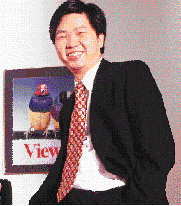ASIAN CALIFORNIA
Page 4 of 12
George Koo was 11 years old in 1949 when his family fled mainland China to escape the advancing Red Army of Mao Tse-tung. Koo's father left China some months earlier to attend college in the United States. The rest of the family joined him once it became clear that abandoning the life they had built for themselves in the city of Amoi (since renamed Xaimen) was perhaps their only hope of ever being reunited.
| "I considered myself more fortunate than the Chinese immigrants older than myself, the ones who came to America in their late teens and early adult years. They had all the disadvantages of being the first generation." |
The Koos settled in Seattle, Washington, near the university where his father was enrolled. Young George soon proudly proclaimed himself a one-and-a-half-generation American, meaning he arrived in the United States well after birth, but still at a young enough age to regard himself a full-fledged native son.
"I considered myself more fortunate than the Chinese immigrants older than myself, the ones who came to America in their late teens and early adult years," he says. "They had all the disadvantages of being the first generation, which is to say, lack of language skills, lack of familiarity with the society and culture. They had to take on menial tasks to support themselves and their families. Everything was a struggle for them.
"The second generation is usually better off than the first. They have the economic support of the first generation and are able to become educated to the point where they can go on to better-paying jobs."
Koo's parents managed to send him to M.I.T. in Boston. After graduation, he returned to Seattle and was hired by Boeing Aircraft Co. Later, he took a job at Allied Chemical, the forerunner of Allied Signal Corp. From there, he joined the Stanford Research Institute in Palo Alto, California. Now, as managing director of International Strategic Alliances and current president of AAMA, he's able to view the big picture of his life, as he considers his good fortune.
"My life was changed when I made the decision to join Chase Manhattan Bank," he says. "That was in 1978. I participated in a group the bank had formed to advise American companies doing business in difficult regions of the world. One of those regions was China, which at the time was just opening up to foreign trade. I was excited about this opportunity. I felt it would be stimulating and challenging, but also would allow me to fulfill a lifetime dream of sorts, which was to cross both cultures and serve as an intermediary--someone who could explain the Americans to the Asians and the Asians to the Americans and figure out ways for both sides to work together and for both sides to win."
As the Chinese Americans build their mini-empires in the Golden State, it's a victory both wide-ranging and leading edge. Just take a look at the leading technology companies of Silicon Valley and Orange County. John Tu left mainland China for Taiwan as a child, came to the U.S. by way of West Germany and now heads Kingston Tech, the billion dollar-plus memory chip distributor; Taiwanese immigrant James Chu turned Viewsonic into a $309 million computer monitor company and a household name in 7 years; Winston Chen's Solectron has its components in nearly every major OEM.
That's not to mention the hundreds, if not thousands, of recent Chinese engineering graduates or Taiwanese transplants who will be developing the core computer technology advances to keep pushing the future's speed limit. Our economy will depend as much on them as our cars do on gasoline. The pockets of these dynamic entrepreneurs, even now, put the banks to shame. These success stories have their roots in a tight, decades-old network of Chinese American families, ingenious Chinese entrepreneurs and links to the mainland where, in a sense, every one belongs to part of the extended family.
 Three California powerhouses: (clockwise from
upper left) ViewSonic founder and CEO James Chu, Kingston Technologies
founder and CEO John Tu, and Solectron CEO Winston Chen, combined bring
about $4 billion dollars into the state each year.
Three California powerhouses: (clockwise from
upper left) ViewSonic founder and CEO James Chu, Kingston Technologies
founder and CEO John Tu, and Solectron CEO Winston Chen, combined bring
about $4 billion dollars into the state each year.


|
It's called guan-xi and it's the keyword to an economic network of some 50 million economically influential Chinese. Influence, access, friendship, connection--guan-xi is what allows a California entrepreneur to go through a friend in Vancouver to put him in touch with an investor in Taiwan. Relationships are essential to the Chinese, and putting people in touch with each other, keeping everyone within the same family, is a key component to the Chinese American success story.
"It's a common belief among the Chinese that we should help each other," says Wilson Chang, a dentist from Monterey Park. "Wherever you go in the world, you will meet someone who knows someone you know."
Like those rotating dinner parties from the movie Joy Luck Club, Chinese families gather to bring together extended family members, friends, their families, children, etc. Chances are they'll have friends in common and stories to share. Page 5
| Page 1 | 2 | 3 | 4 | 5 | 6 | 7 | 8 | 9 | 10 | 11 | 12 |
CONTACT US
|
ADVERTISING INFO
© 1996-2013 Asian Media Group Inc
No part of the contents of this site may be reproduced without prior written permission.
